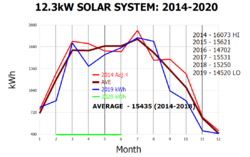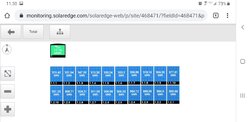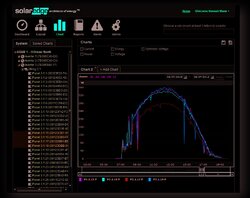Six full years of solar PV are now history. The graph shows the results. 2019 set a record annual low, ending up slightly lower than 2016, the prior low year. 2019 year was plagued by smoke from Canadian and western US forest fires and day upon day of cloudy/rainy weather.
I'm leaving the average line at the five year period 2014-18 rather than have a rolling forward average. This is just an intuitive sense that the first five years should be years when the panels are producing the highest with minimal degradation. Panel specs that I have seen assume a 0.5% annual degradation. At this point I don't have the skill or measuring ability to actually plot degradation impact, but over time and as more years pass it may be possible to see degradation by the data I do collect. Day to day weather impacts annual production significantly. For example, seeing degradation is made more difficult by the impact of as little a single day with clear skies, with the maximum daily production I have seen being just over 90kWh, and another day with dense clouds producing just a few kWh. That single "HI" day vs "LO" day alone can impact annual production by about 0.5%.

I'm leaving the average line at the five year period 2014-18 rather than have a rolling forward average. This is just an intuitive sense that the first five years should be years when the panels are producing the highest with minimal degradation. Panel specs that I have seen assume a 0.5% annual degradation. At this point I don't have the skill or measuring ability to actually plot degradation impact, but over time and as more years pass it may be possible to see degradation by the data I do collect. Day to day weather impacts annual production significantly. For example, seeing degradation is made more difficult by the impact of as little a single day with clear skies, with the maximum daily production I have seen being just over 90kWh, and another day with dense clouds producing just a few kWh. That single "HI" day vs "LO" day alone can impact annual production by about 0.5%.



 Highly unlikely someone will be able to prove it even if the manufacturer is still in the solar business. Most of the time I hear claims of underperforming systems its usually external like shading caused by landscaping. I know I have one 17 year old array that suffering from that problem, the small trees off to the sides have grown a lot taller in 17 years. Generally the actual silicon chip electrical conversion isnt the issue, its encapsulant deterioration. I have a 20 year ARCO/Shell/Siemens/Solar World) panel on my SHW system pump where the encapsulant is cooked, not as bad as the old ARCO crispy critters quadlams that gave a lot of folks their start in solar long ago, but still quite cloudy. It still does what it needs to so I am just going to run it until it does not.
Highly unlikely someone will be able to prove it even if the manufacturer is still in the solar business. Most of the time I hear claims of underperforming systems its usually external like shading caused by landscaping. I know I have one 17 year old array that suffering from that problem, the small trees off to the sides have grown a lot taller in 17 years. Generally the actual silicon chip electrical conversion isnt the issue, its encapsulant deterioration. I have a 20 year ARCO/Shell/Siemens/Solar World) panel on my SHW system pump where the encapsulant is cooked, not as bad as the old ARCO crispy critters quadlams that gave a lot of folks their start in solar long ago, but still quite cloudy. It still does what it needs to so I am just going to run it until it does not.
